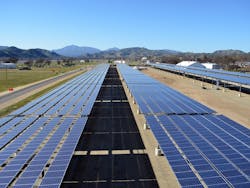Army to equip all bases with microgrids by 2035 as part of carbon-free electricity goal
Saying it wants to lead by example, the US Army plans to build a microgrid at each of its 130 bases worldwide as part of a larger climate strategy released on Tuesday.
“The effects of climate change have taken a toll on supply chains, damaged our infrastructure, and increased risks to Army soldiers and families due to natural disasters and extreme weather,” said Army Secretary Christine Wormuth in a forward to the climate strategy report describing the plan. “If we do not take action now, across our installations, acquisition and logistics, and training, our options to mitigate these risks will become more constrained with each passing year.”
Already a strong promoter of the microgrid concept, the military’s various branches in recent years have announced a host of microgrid projects, an effort largely driven by a desire to bring energy independence to their facilities. The US Navy, for example, has a goal to make its key installations capable of operating off-grid for at least two weeks by late 2025.
Several microgrid projects are already in development or operation at various Army bases, among them Fort Hunter Liggett in California, the Redstone Arsenal in Alabama and Fort Bragg in North Carolina.
The climate strategy report said that the Army has 24 microgrid projects scoped and planned through 2024 with the intent of microgridding all of its bases by 2035. The plan calls for working with adjacent communities and other stakeholders and partners to create the microgrids.
The microgrid projects are being built in accordance with an energy and water plan that the Army released in 2020 to lower costs and make its facilities more resilient and efficient.
Microgrid projects for contingency sites too
In addition to installing permanent microgrids, the Army also intends to pursue microgrids for its temporary sites known as “contingency bases,” which are now heavily reliant on fossil fuels. The goal is to make the contingency bases carbon-free by 2050.
The Army began tackling carbon emissions at contingency bases in 2013 with more efficient fossil fuel generators. But to get the most out of the generators, they need to be integrated into microgrids with battery storage, the report said.
“The necessary battery technology exists and is improving every year, and the Army will move to acquire, implement and help advance this technology. In addition, the Army will enact a new policy, setting standards for using the most energy-efficient systems available for contingency basing, including renewable generation and battery storage where possible, to minimize base fuel demands,” the report said.
The Army’s climate plan also calls for electrifying fleets; specifically making all nontactical light vehicles electric by 2027 and doing the same for the remaining nontactical vehicles by 2035. Fleet electrification is expected to be a driver generally of microgrid development in the coming years, as it increases the amount of electricity the world will need and requires that it be available in locations that lack adequate grid infrastructure.
Watch our interview with Ameresco’s Nicole Bulgarino about a floating solar microgrid project at Fort Bragg.
The plan also calls for procuring enough renewables and battery storage “to self-sustain its critical missions” on all Army installations by 2040.
Larger climate goal
Its larger goal is to achieve on-site carbon pollution-free power for installations by 2030 and critical missions by 2040. The report calculates that the Army produced 4.1 million metric tons of carbon dioxide as well as methane, nitrous oxide and other greenhouse gases (GHG) from the $740 million in grid electricity purchases that it made in 2020.
“While the Army has decreased overall installation GHG emissions by 20% since 2008, the service can do more to incentivize greening the grid,” the report said.
Wormuth challenged the Army “to examine climate threats, prioritize resources and take swift action.”
“For today’s soldiers operating in extreme temperature environments, fighting wildfires and supporting hurricane recovery, climate change isn’t a distant future, it is a reality,” Wormuth said. “The time to address climate change is now.”
Nicole Bulgarino, executive vice president of Ameresco, a Massachusetts company that frequently works with the military on energy projects, including microgrids, described the climate plan as reflecting “admirable leadership and willingness to take action from the nexus of national security and climate change. Clean energy is the clear path forward to both preserve the resiliency needed for national security and address the negative impact of climate change to secure a better future.”
Interested in military microgrids? Learn more at Microgrid 2022: Microgrids as Climate Heroes. Early registration discount ends Feb. 28.
About the Author
Elisa Wood
Editor-in-Chief
Elisa Wood is the editor and founder of EnergyChangemakers.com. She is co-founder and former editor of Microgrid Knowledge.
